A Low-Noise, High-Gain, and Small-Size UWB Mixer Utilizing Negative Impedance Technique and Source Input Method
Abstract
:1. Introduction
2. Circuit Design and Analysis
2.1. Negative Impedance
2.2. Source Input
3. Derivation of the Mixer Parameters
- (1)
- Assuming a symmetrical LO signal as shown in Figure 5, with the rise/fall time equal to , the constants and can be rewritten as , .
- (2)
- In (, ), N1 and N4 are on and N2 and N3 are off, while in (, ), N1 and N4 are off and N2 and N3 are on.
- (3)
- S1 and S2 are ideal current sources with infinite internal impedance.
3.1. Flicker Noise
3.2. Convertion Gain
4. Simulation Results and Discussion
5. Conclusions
Author Contributions
Funding
Conflicts of Interest
References
- Revision of Part 15 of the Commission’s Rules Regarding Ultra-Wideband Transmission Systems; FCC: Washington, DC, USA, 2002.
- Martín, J.S.; Cortés, A.; Zamora-Cadenas, L.; Svensson, B.J. Precise positioning of autonomous vehicles combining UWB ranging estimations with on-board sensors. Electronics 2020, 9, 1238. [Google Scholar] [CrossRef]
- Bao, D.; Zou, Z.; Nejad, M.B.; Qin, Y.; Zheng, L.-R. A wirelessly powered UWB RFID sensor tag with time-domain analog-to-information interface. IEEE J. Solid State Circuits 2018, 53, 2227–2239. [Google Scholar] [CrossRef]
- Vogli, E.; Ribezzo, G.; Grieco, L.A.; Boggia, G. Fast network joining algorithms in industrial IEEE 802.15.4 deployments. Ad Hoc Netw. 2018, 69, 65–67. [Google Scholar] [CrossRef]
- Liang, K.-H.; Chang, H.-Y.; Chan, Y.-J. A 0.5–7.5 GHz ultra low-voltage low-power mixer using bulk-injection method by 0.18-μm CMOS technology. IEEE Microw. Wirel. Compon. Lett. 2007, 17, 531–533. [Google Scholar] [CrossRef]
- Kuo, C.-L.; Huang, B.-J.; Kuo, C.-C.; Lin, K.-Y.; Wang, H. A 10–35 GHz low power bulk-driven mixer using 0.13-μm CMOS process. IEEE Microw. Wirel. Compon. Lett. 2008, 18, 455–457. [Google Scholar]
- Kim, M.G.; An, H.W.; Kang, Y.M.; Lee, J.Y.; Yun, T.Y. A low-voltage, low-power, and low-noise UWB mixer using bulk-injection and switched biasing techniques. IEEE Trans. Microw. Theory Tech. 2012, 60, 2486–2493. [Google Scholar] [CrossRef]
- Bhatt, D.; Mukherjee, J.; Redouté, J.-M. Low-power linear bulk-injection mixer for wide-band applications. IEEE Microw. Wirel. Compon. Lett. 2016, 26, 828–830. [Google Scholar] [CrossRef]
- Klumperink, E.A.M.; Louwsma, S.M.; Wienk, G.J.M.; Nauta, B. A CMOS Switched Transconductor Mixer. IEEE J. Solid State Circuits 2004, 39, 1231–1240. [Google Scholar] [CrossRef] [Green Version]
- Lee, S.; Bergervoet, J.; Harish, K.S.; Leenaerts, D.; Roovers, R.; van de Beek, R.; van der Weide, G. A Broadband Receive Chain in 65nm CMOS. In Proceedings of the IEEE International Solid-State Circuits Conference, San Francisco, CA, USA, 11–15 February 2007; pp. 418–420. [Google Scholar]
- Li, H.; El-Gabaly, A.M.; Saavedra, C.E. A low-power low-noise decade-bandwidth switched transconductor mixer with AC-coupled LO buffers. IEEE Trans. Circuits Syst. 2018, 65, 510–521. [Google Scholar] [CrossRef]
- NacEachern, L.A.; Manku, T. A charge-injection method for Gilbert cell biasing. In Proceedings of the IEEE Canadian Conference on Electrical and Computer Engineering, Waterloo, ON, Canada, 25–28 May 1998; pp. 365–368. [Google Scholar]
- Darabi, H.; Chiu, J.A. Noise cancellation technique in active RF-CMOS mixers. IEEE J. Solid-State Circuits 2005, 40, 2628–2632. [Google Scholar] [CrossRef]
- Yoon, J.; Kim, H.; Park, C.; Yang, J.; Song, H.; Lee, S.; Kim, B. A new RF CMOS Gilbert mixer with improved noise figure and linearity. IEEE Trans. Microw. Theory Tech. 2008, 56, 626–631. [Google Scholar] [CrossRef]
- Cheng, W.; Annema, A.J.; Wienk, G.J.M.; Nauta, B. A flicker noise/IM3 cancellation technique for active mixer using negative impedance. IEEE J. Solid State Circuits 2013, 48, 2390–2402. [Google Scholar] [CrossRef] [Green Version]
- Motieifar, A.; Pour, Z.A.; Bridges, G.; Shafai, C.; Shafai, L. An ultra wideband (UWB) mixer with 0.18um RF CMOS technology. In Proceedings of the IEEE Canadian Conference on Electrical and Computer Engineering, Ottawa, ON, Canada, 7–10 May 2006; pp. 697–700. [Google Scholar]
- Darabi, H.; Abidi, A.A. Noise in RF-CMOS mixers: A simple physical model. IEEE J. Solid State Circuits 2000, 35, 15–25. [Google Scholar] [CrossRef]
- Sansen, W.M.C.; Meyer, R.G. Distortion in bipolar transistor variable-gain amplifiers. IEEE J. Solid State Circuits 1973, 8, 275–282. [Google Scholar] [CrossRef]
- Cheng, W.; Annema, A.J.; Croon, J.A.; Nauta, B. Noise and nonlinearity modeling of active mixers for fast and accurate estimation. IEEE Trans. Circuits Syst. 2011, 2, 276–289. [Google Scholar] [CrossRef]
- Jouri, M.; Golmakani, A.; Yahyabadi, M.; Khosrowjerdi, H. Design and simulation of a down-conversion CMOS mixer for UWB applications. In Proceedings of the International Conference on Electrical Engineering/Electronics, Computer, Telecommunications and Information Technology, Chiang Mai, Thailand, 19–21 May 2010; pp. 937–940. [Google Scholar]
- Zhang, X.; Cui, X.; Wang, B.; Lee, C.L. A high gain, wide band (2–10 GHz), and low noise active balun merged folded mixer for the full-band UWB application. In Proceedings of the IEEE International Wireless Symposium, Beijing, China, 14–18 April 2013; pp. 1–3. [Google Scholar]
- Chen, J.-D.; Qian, J.-B.; Huang, S.-Y. Low-noise and high-gain folded mixer for a UWB System in 0.18-μm SiGe Bi-CMOS technology. IEEE Trans. Circuits Syst. 2021, 68, 612–616. [Google Scholar]
- Ebrahimi, A.; Hemmati, M.J.; Hakimi, A.; Afrooz, K. A new low-power and high-linearity CMOS bulk injection mixer in 0.13 μm technology. In Proceedings of the Iranian Conference on Electrical Engineering, Mashhad, Iran, 8–10 May 2018; pp. 108–113. [Google Scholar]
- Seyedi, H.; Dehdasht-Heydari, R.; Roshani, S. UWB down-conversion mixer using an IM3 cancellation modified technique for zero and low IF applications. Microelectron. J. 2021, 109, 104983–104989. [Google Scholar] [CrossRef]
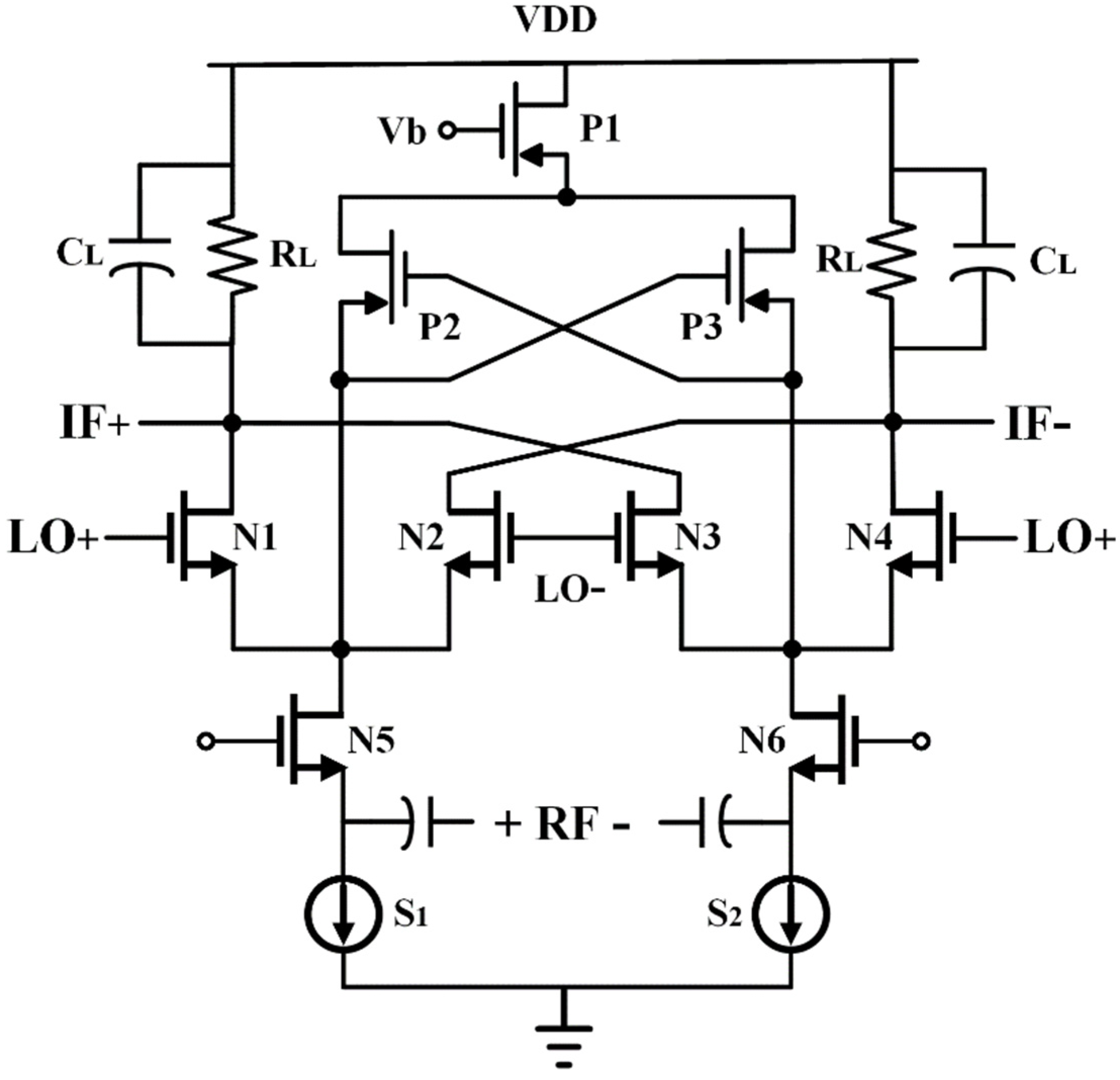






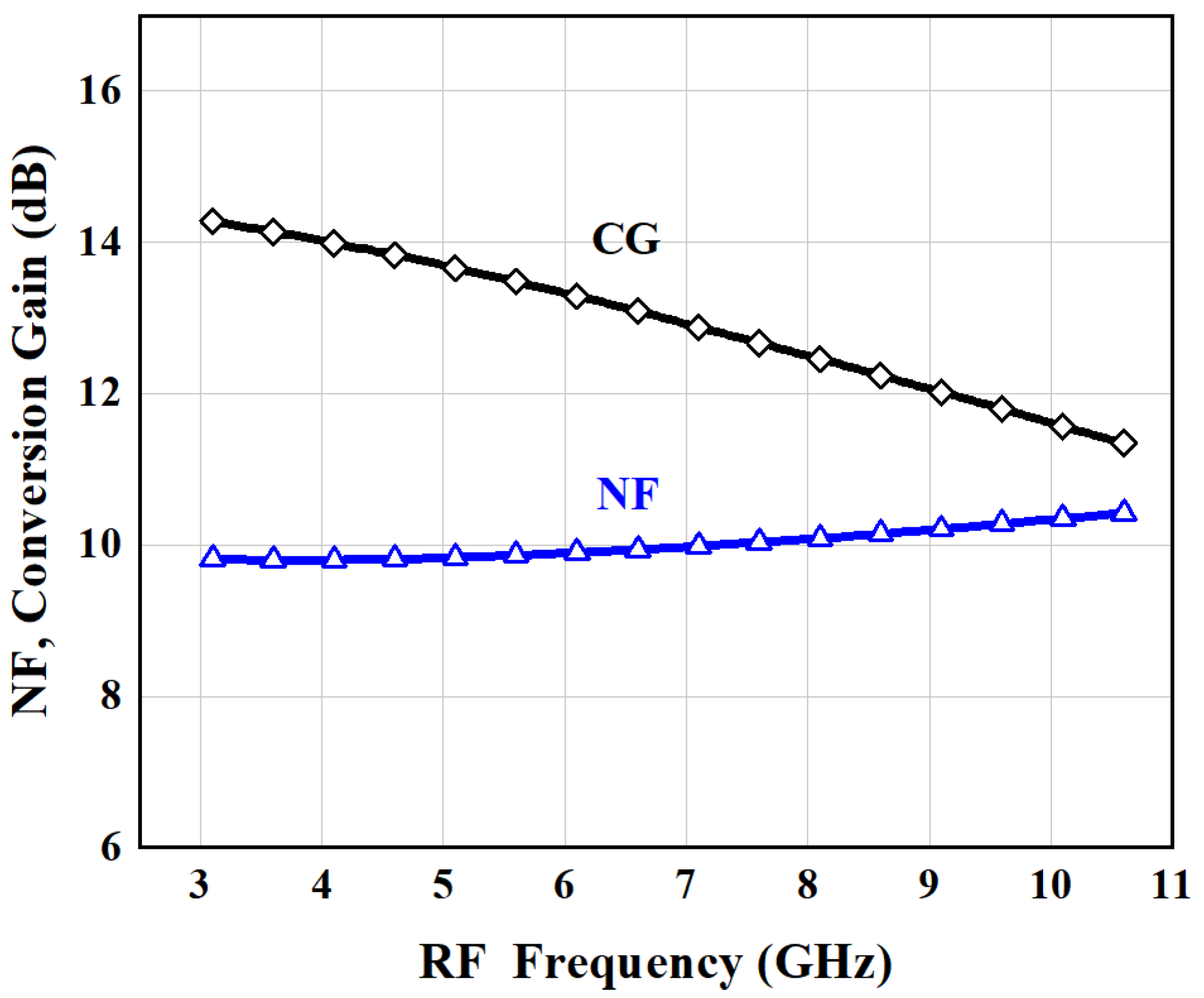
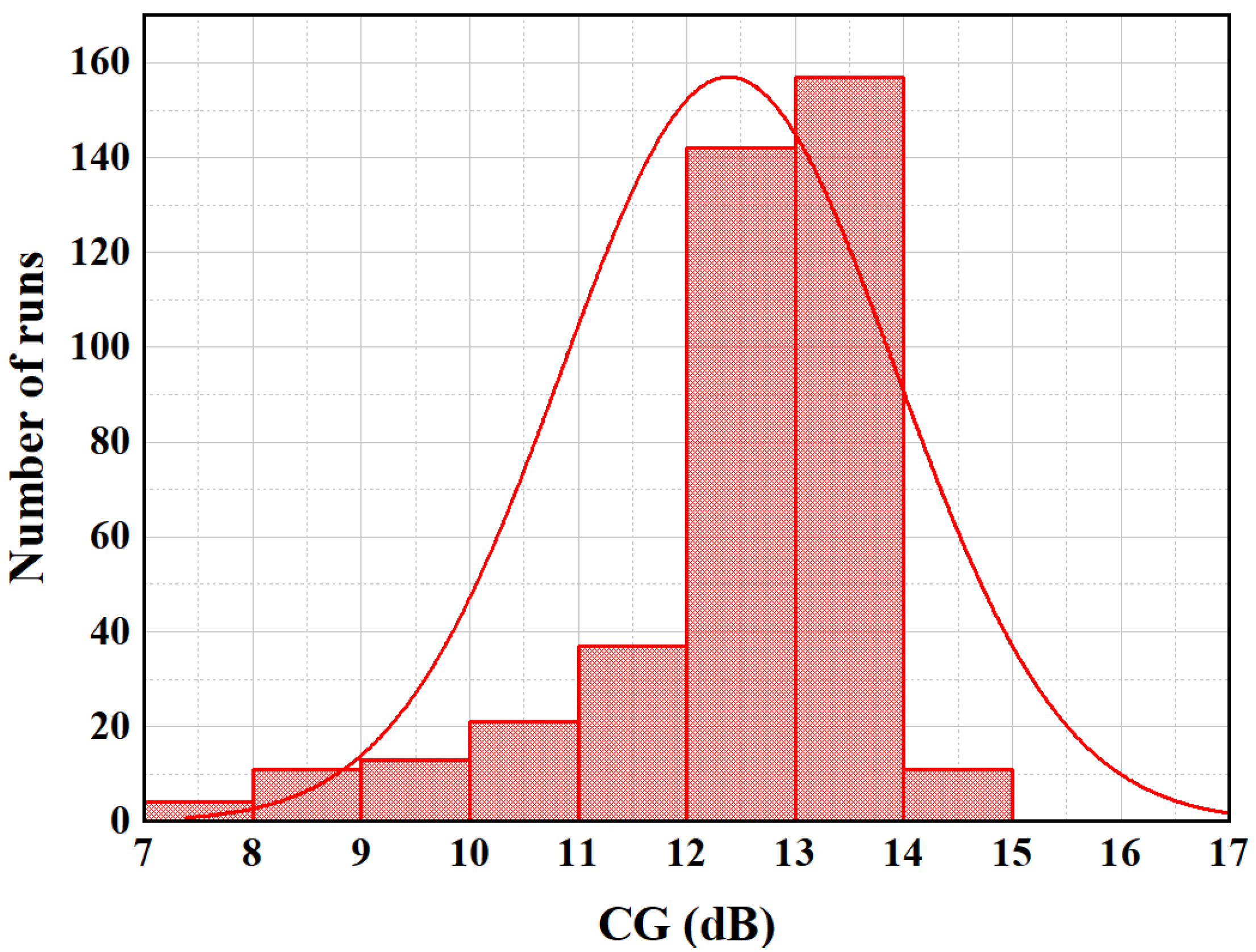
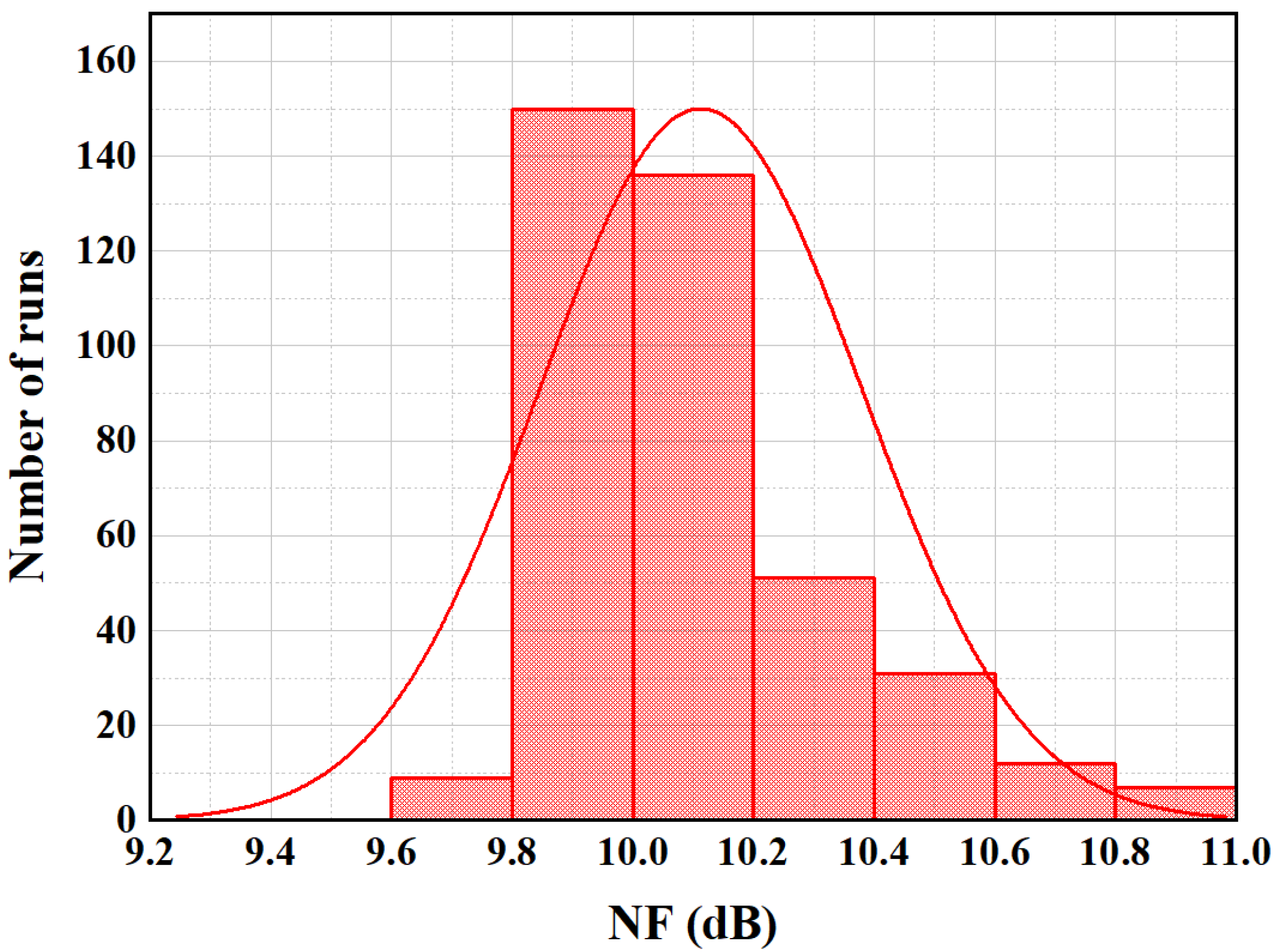
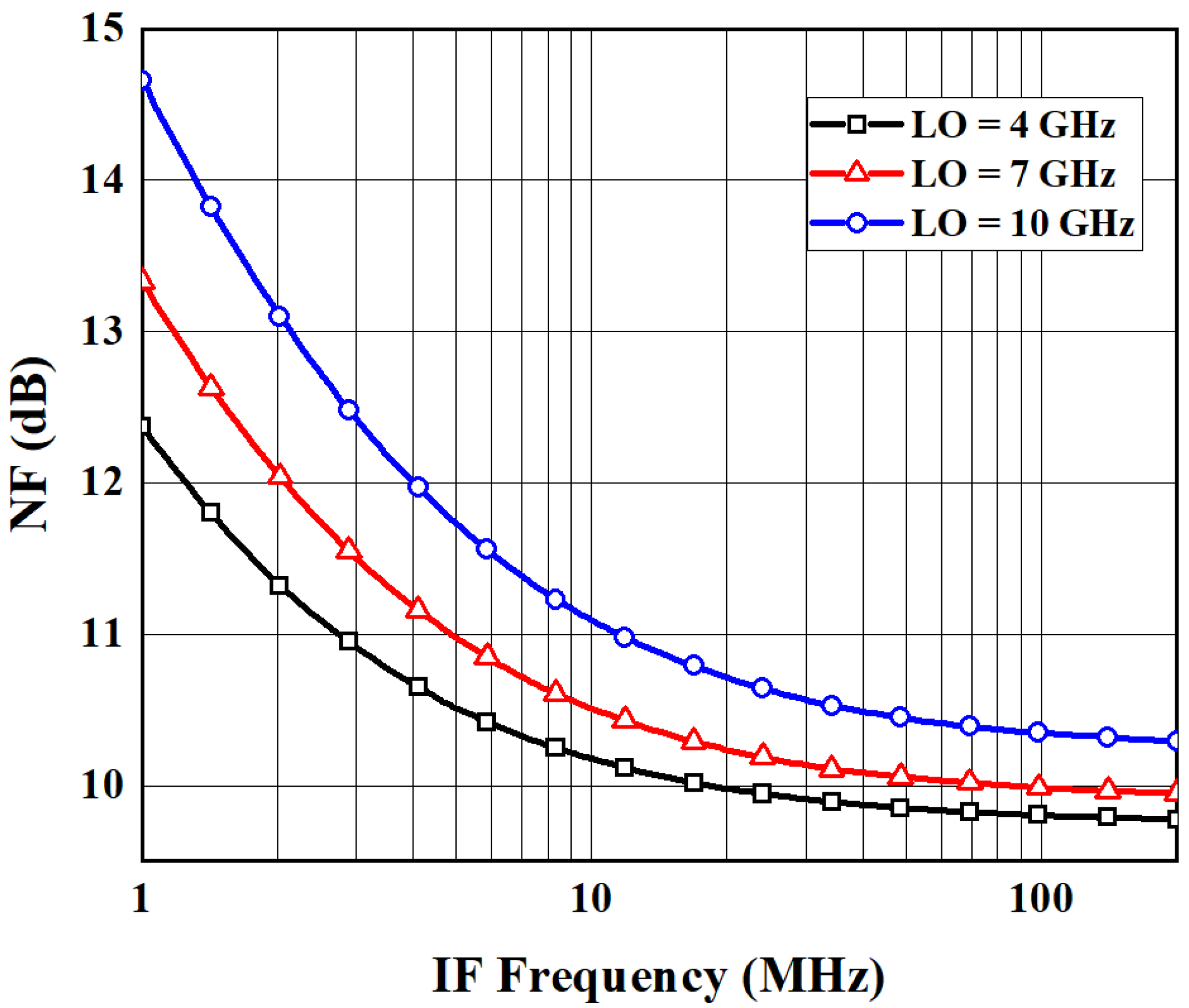

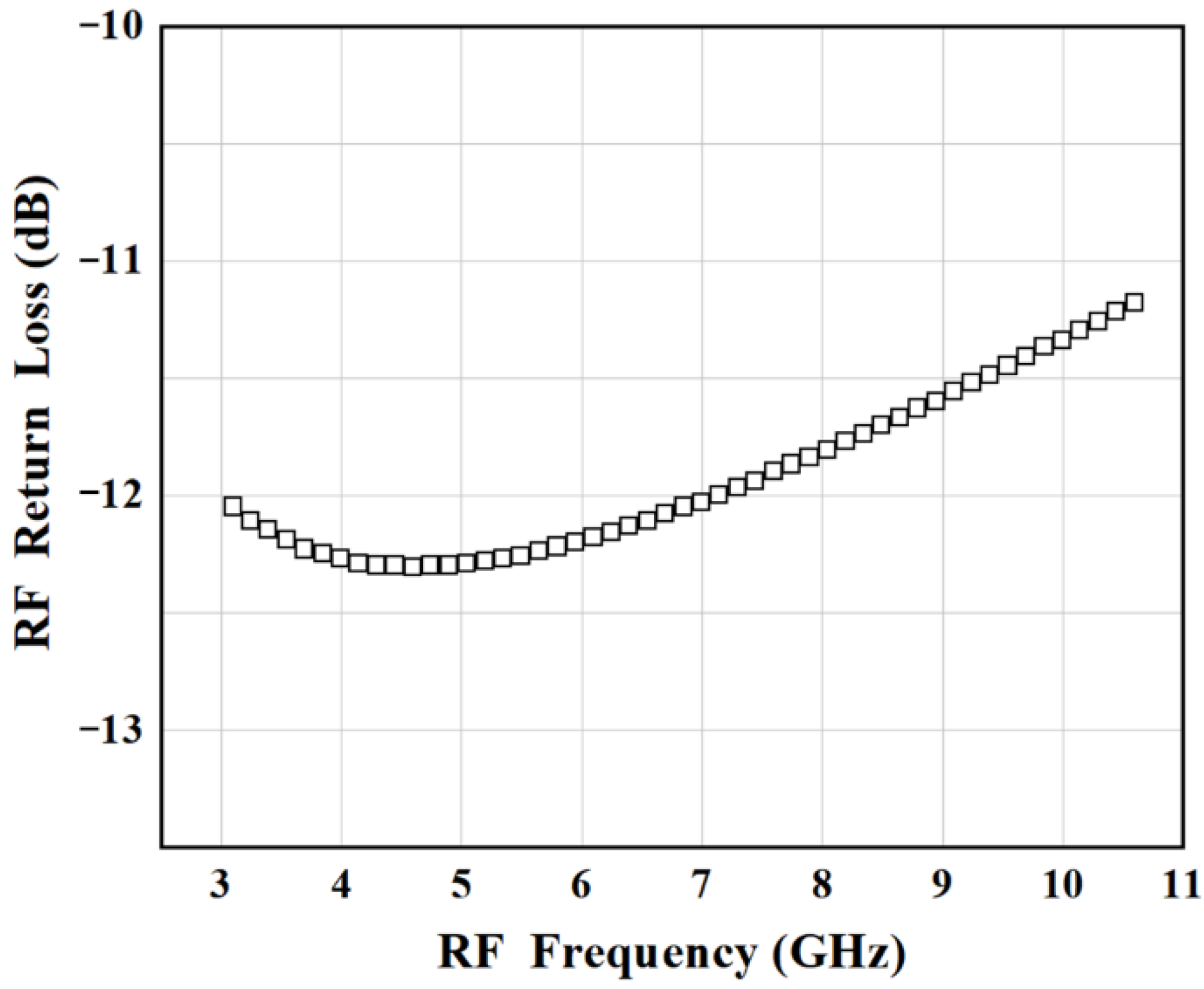
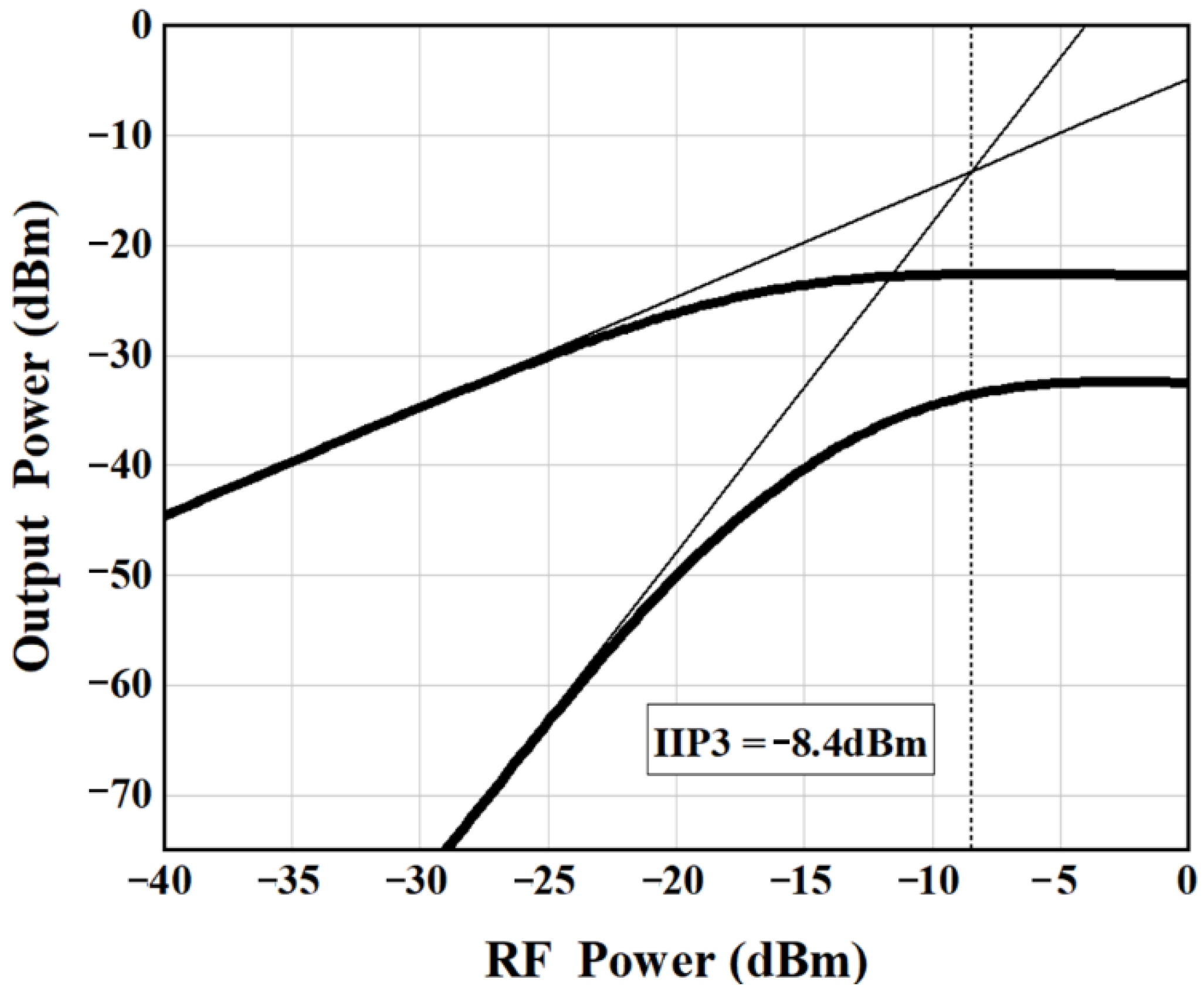


| Refer. | Freq. (GHz) | Process (um) | IF (MHz) | CG (dB) | LO (dBm) | DSB NF (dB) | IIP3 (dBm) | VDD (V) | PDC (mW) | Area (mm) |
|---|---|---|---|---|---|---|---|---|---|---|
| 10′ [20] a | 3–11 | 0.18 | 250 | 9.5–12.5 | - | 8 | 2 | 1.8 | 8.5 | - |
| 12′ [7] b | 0.2–13 | 0.18 | 264 | 5.6–9.9 | 5 | 11.7 | −10 | 0.8 | 0.88 | 0.58 × 0.62 |
| 13′ [21] a | 2–10 | 0.18 | 100 | 8.1–17.6 | 6 | 12.6 | −1.7 | 1.8 | 7.8 | 0.77 × 1.14 |
| 16′ [8] b | 1–6 | 0.18 | 100 | 4–7 | 8.7 | 13.5 | 0 | 1.8 | 0.63 | - |
| 21′ [22] b | 3–11 | 0.18 | 264 | 8.8–17.1 | 7 | 9.8 | −5 | 2.5 | 0.63 | 0.88 × 0.89 |
| 18′ [23] a | 3.1–8.5 | 0.13 | 10 | 12.7–13.7 | −6 | 13.7 | 8.5 | 1.6 | 0.45 | - |
| 21′ [24] a | 0.9–5 | 0.065 | 1 | 10.8–11.8 | 5 | 16.9 | 20.5 | 1.2 | 3.5 | 0.13 × 0.39 * |
| This work a | 3.1–10.6 | 0.045 | 100 | 11.4–14.3 | −1 | 9.8 | −8.4 | 1 | 2.85 | 0.39 × 0.69 |
Publisher’s Note: MDPI stays neutral with regard to jurisdictional claims in published maps and institutional affiliations. |
© 2021 by the authors. Licensee MDPI, Basel, Switzerland. This article is an open access article distributed under the terms and conditions of the Creative Commons Attribution (CC BY) license (https://creativecommons.org/licenses/by/4.0/).
Share and Cite
Zhou, Z.; Li, X.; Wang, X.; Gu, W. A Low-Noise, High-Gain, and Small-Size UWB Mixer Utilizing Negative Impedance Technique and Source Input Method. Electronics 2021, 10, 2655. https://doi.org/10.3390/electronics10212655
Zhou Z, Li X, Wang X, Gu W. A Low-Noise, High-Gain, and Small-Size UWB Mixer Utilizing Negative Impedance Technique and Source Input Method. Electronics. 2021; 10(21):2655. https://doi.org/10.3390/electronics10212655
Chicago/Turabian StyleZhou, Zhaokun, Xiaoran Li, Xinghua Wang, and Wei Gu. 2021. "A Low-Noise, High-Gain, and Small-Size UWB Mixer Utilizing Negative Impedance Technique and Source Input Method" Electronics 10, no. 21: 2655. https://doi.org/10.3390/electronics10212655






